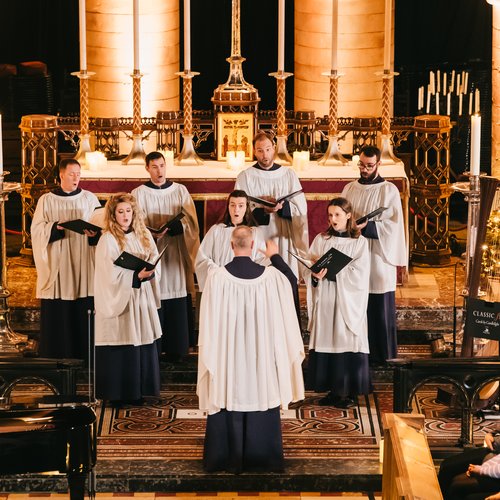Gustav Holst: A Life
“If nobody likes your work, you have to go on for the sake of the work. And you’re in no danger of letting the public make you repeat yourself.” So said one of Britain’s most daringly inventive composers, Gustav Holst
He was one of English music’s great originals: as Holst progressed meticulously from one new work to the next, his followers could only hazard a guess as to what might be in the offing – whether it be Hindu mysticism or astronomical fantasy.
Like Stravinsky, Holst was reluctant to wear his heart on his sleeve, preferring to pare music down to its bare essentials. So it comes as no surprise to learn that he was a firm admirer of the Renaissance masters – particularly Byrd and Palestrina – through whom he developed a fascination with old-fashioned-sounding “modes”, which he preferred to the modern scale.
Holst could knock out a winning tune whenever the situation demanded (as witness the central section of Jupiter, memorably adapted to the words “I vow to thee my country”), but his true métier was the refined, the spiritual, the incalculable, the unfathomable.
Typical are the Seven Partsongs he composed to words by the then Poet Laureate, Robert Bridges, whose elusive and mystical poems appealed instinctively to Holst.
He later recalled: “I did the first of the Bridges poems the moment I caught sight of the words, since when I’ve been wondering what they mean.”
If Holst is a composer that people tend to admire rather than fall in love with, his music at its finest rivals most things his continental colleagues can offer.
Holst’s posthumous reputation rests almost entirely on one blazing masterpiece, The Planets (1914-16). Yet he never thought all that highly of it, nor allowed its overwhelming popularity to throw him off course.
Clear-sighted and sure-footed to the end, for him one rule of composition was immutable: “Never compose anything unless the not-composing of it becomes a positive nuisance to you.”
There is little about Holst’s early life that even remotely suggests a great master in the making. Born Gustavus Theodore von Holst in Cheltenham in 1874, his grandfather was a harp teacher from Riga, Latvia, and his father, Adolph, an organist and choirmaster. Holst dropped the “von” from his surname in 1918 because of the German connotation.
Early piano lessons with his father seemed to point the way forward for a while, but intermittent neuritis in Gustav’s right arm soon put paid to any thought of a virtuoso career. Holst turned to composition in his spare time, teaching himself as he went along from Berlioz’s famous treatise on orchestration.
Lessons under Stanford at the Royal College of Music in London were hardly auspicious but Holst bravely battled on, having fallen heavily under the spell of Wagner’s epic music-dramas.
Gaining some conducting experience with amateur choirs (he met his wife, Isobel, in one – their only child, Imogen, herself became a respected musician), Holst meanwhile developed a lifelong passion for the music of Purcell, while learning Sanskrit on the side as the result of his first encounters with Hindu literature and philosophy.
Upon leaving college in 1898, Holst was forced to fall back on playing the trombone in order to earn a basic crust, but short spells in the pit with the Carl Rosa Opera Company and on tour with the Scottish Orchestra simply reinforced his desire to compose.
However, it was not until he first encountered English folksong through his close friendship with Vaughan Williams and had gained financial security via a teaching post at St Paul’s Girls’ School in Hammersmith (where he was known as “Gussie”) that his talent slowly began to emerge.
Holst’s composing career gradually gathered pace with two Queen’s Hall premieres: the folksy A Somerset Rhapsody (1906-07) and the oriental suite Beni Mora (1909-10), followed by the typically sparing and ascetic Choral Hymns from the Rig Veda (1908-12), using texts he himself translated from Sanskrit.
Yet his most popular work of this period was written with rather younger players in mind: the St Paul’s Suite (1912-13). Holst was a great believer in giving young people contemporary and challenging music to play and it is testimony to the high standards he achieved that such a piece should have been composed specifically for the girls in his charge.
The finale ingeniously combines two traditional folk tunes in counterpoint with one another – the Dargason and Greensleeves. The latter would go on to achieve immortality when Vaughan Williams based a Fantasia on it in 1934.
For the time being, Holst continued to fit composing around his teaching commitments, although there was little even now to suggest he was remotely capable of producing music of such all-encompassing originality and mastery as The Planets.
Composed mostly during 20-minute breaks at school and during the holidays, this hit the British music scene like a thunderbolt, despite having to wait until 1920 before receiving its first complete public performance.
Almost overnight Holst, who was by then already in his 40s, found himself elevated from the position of a struggling amateur into a national celebrity. Revealingly, of the work’s seven movements Holst preferred not the sensuality of Venus, nor the high-spirited outbursts of Jupiter, nor Mars’s thunder, but the austere tread of Saturn.
No one could have blamed Holst if he’d capitalised on his success with another orchestral barnstormer, yet his next major work was The Hymn Of Jesus, a work of true genius, but hardly a crowd-pleaser.
Holst learned Greek especially to translate the original poems, and freely employed plainsong throughout in order to enhance the ecstatic, devotional atmosphere. The first performance was a huge success; the work’s dedicatee Vaughan Williams said that he “just wanted to get up and embrace everyone and then get drunk”.
Fired by his latest musical creation Holst wrote to a friend at the time: “Why do we waste our lives trying to teach! (Don’t trouble to answer – I’ve already thought of several answers).”
No less uncompromising was the opera The Perfect Fool (1923), which Holst’s daughter Imogen recalled left the audience feeling “uncomfortable, not quite knowing when they were supposed to laugh.”
The Fugal and Double Concertos (1923 & 1929) found Holst turning delightfully neo-classical (it was currently all the rage in Paris), but the rugged bleakness of Egdon Heath (1928) left many bewildered, mistaking his sparing gestures for creative aridity. Holst, though, was undaunted – he rightly knew he had created his greatest masterpiece.
Meanwhile, a break from the unrelenting stress of trying to balance the life of a professional musician with his school duties came quite suddenly and with near-tragic results. While in Reading conducting a student orchestra in 1923, he lost his footing on the podium and fell back awkwardly on his head.
At first it seemed all was reasonably well despite spells of insomnia and recurring headaches, yet as the year went on Holst was clearly close to nervous collapse. He took the whole of 1924 off under doctor’s orders, and from 1925 reduced his teaching activities to a mere trickle.
It was now that Holst entered what was arguably the most remarkable period of his creative life, this despite constant admonitions from music lovers and colleagues that his music had become too remote and forbidding in tone.
Even Vaughan Williams fervently hoped that the two men might not “drift apart, musically speaking”. Yet Holst knew his own mind, his continuing process of refinement and formal mastery resulting in the haunting, reductive masterpiece, the Six Medieval Choruses (1931-32).
Holst’s reputation remained unimpaired as is evidenced by the large number of commemorative awards he received – including the Royal Philharmonic Society’s gold medal in 1930 – and the celebratory Holst Festival held in Cheltenham in 1927.
Just as it looked as though his life might take another turn with his appointment to Harvard University as a visiting composition lecturer early in 1932, a duodenal ulcer caused an attack of gastritis from which he never fully recovered.
Unbelievably, he chose this moment to compose his most quintessentially English, unaffectedly pastoral work, the Brook Green Suite (named after the location of St Paul’s Girls’ School).
It is difficult to imagine such untroubled music as the sublimely lyrical slow movement and irresistible Jig finale emanating from the pen of a dying man. Following an operation, and in great pain, on 25 May 1934 Holst passed away, some four months after Edward Elgar, and little more than a fortnight before Frederick Delius.
Commenting on his music to a close friend shortly before he died, Holst declared: “I believe very strongly that we are largely the result of our surroundings and that we never do anything alone. Everything that is worth doing is the result of several minds playing on each other.”












